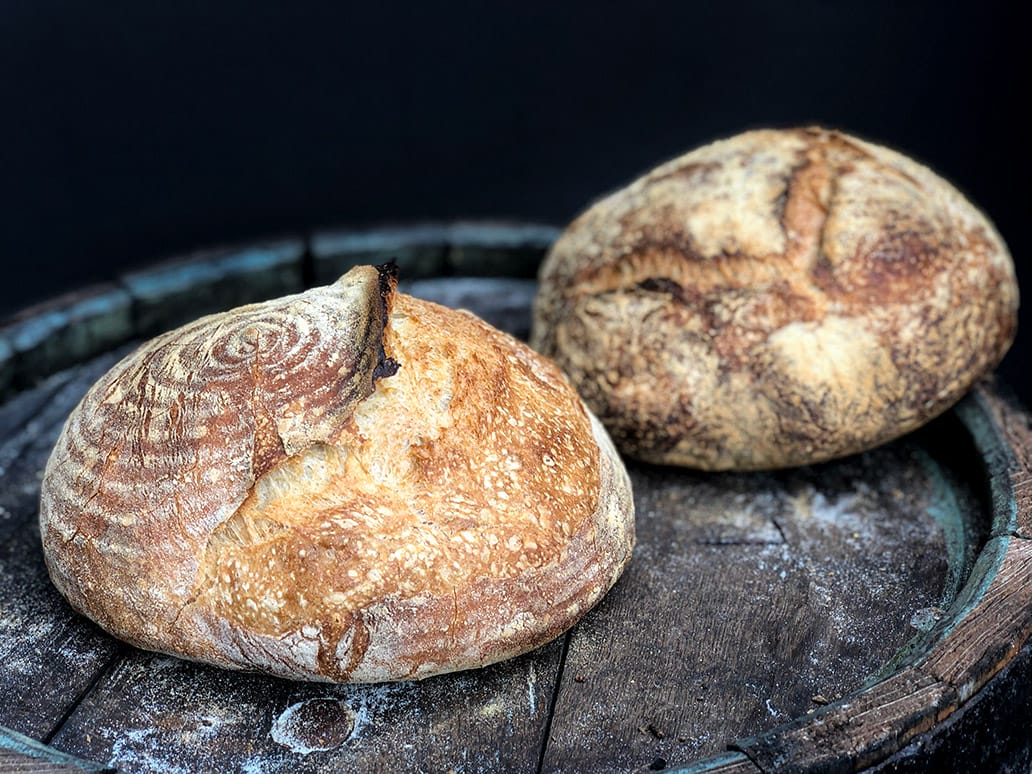
Ingredients (for 2 loaves of 750 g each)
Proofing: 12-14 hours
Proofing: approx. 1 hour
Mix the flour and water in a large mixing bowl of the food processor. First mix roughly with a wooden spoon, then knead with your hands until the ingredients have combined. Cover and leave to stand for 20-60 minutes.
Dissolve the yeast in 50 g of water in a small bowl.
Add the salt and dissolved yeast to the mixing bowl and knead all the ingredients with the dough hook until the dough has a smooth surface. Remove the dough from the bowl with a moistened dough card, fold it in and place it in a large bowl, light oiled, Place in a bowl or proofing tray (with lid). This is best done with moistened hands. The dough is very soft and sticky.
Cover the dough and leave to stand at room temperature for 12-14 hours. It will increase in volume considerably.
Dust two proofing baskets well with semola or wheat mist.
Dust the work surface well with flour.
Dust your hands with flour, carefully remove the dough from the side of the bowl and tip it onto the work surface. Handle the dough very carefully. The gases that have formed should remain in the dough as much as possible. Divide into two equal pieces using a floured dough card.
Now it's time to shape. Use the floured pastry card to ensure that the underside of the dough does not stick to the work surface. Now fold the dough from all sides towards the center. Pull, but do not tear! Repeat this process all the way round until you have a round loaf with a little tension. Turn the dough piece over. (The seam is now at the bottom.) Wrap your hands around the dough piece and bring it towards you, applying slight pressure. Repeat this 3-4 times all around. This creates more tension in the dough.
Now there are two possibilities:
Cover the proofing baskets and leave to rise again at room temperature.
Leave to rise for approx. 1 hour.
During this time, heat the Merklinger to approx. 300°C and place the pot (with lid) on the firebrick in the oven while it is heating up. After 50-60 minutes, the pot will be hot enough and you can start cooking.
Prepare a place to work because the pot is very hot and you need somewhere to put the lid. Remove the hot pot from the Merklinger using the oven gloves. Open the lid and put it to one side. Caution: Very hot air/steam escapes from the pot!
Carefully tip the dough onto the floured work surface. If you want to cut the bread, now is the right time. Carefully place the dough piece in the pan. Caution: Do not touch the sides of the pan! Close the pot with the lid and immediately place it in the hot Merklinger.
Hold at 300 °C for 30 minutes. After this time, carefully remove the lid with an oven glove and finish baking the bread for approx. 20 minutes. During this time, it will still have a good portion of wood-fired oven flavor.
Remove the pan from the oven with the gloves on and place on a heatproof surface. Turn out the bread and leave to cool on a rack.
Tips:
Messerschmittring 19
86343 Königsbrunn
Phone +49 (0)8231 9883584
info@dermerklinger.de









Do you have specific questions about the Merklinger or would you like a personal consultation? Then fill in the contact form below and we will get back to you shortly.